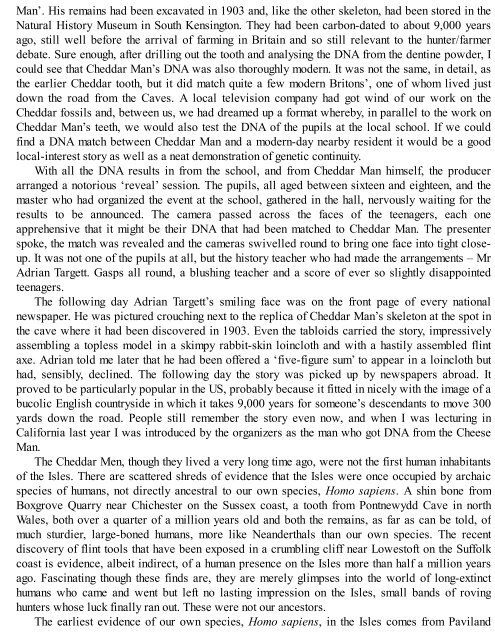You also want an ePaper? Increase the reach of your titles
YUMPU automatically turns print PDFs into web optimized ePapers that Google loves.
Man’. His remains had been excavated in 1903 and, like the other skeleton, had been stored in the<br />
Natural History Museum in South Kensington. They had been carbon-dated to about 9,000 years<br />
ago, still well before the arrival of farming in Britain and so still relevant to the hunter/farmer<br />
debate. Sure enough, after drilling out the tooth and analysing the DNA from the dentine powder, I<br />
could see that Cheddar Man’s DNA was also thoroughly modern. It was not the same, in detail, as<br />
the earlier Cheddar tooth, but it did match quite a few modern Britons’, one of whom lived just<br />
down the road from the Caves. A local television company had got wind of our work on the<br />
Cheddar fossils and, between us, we had dreamed up a format whereby, in parallel to the work on<br />
Cheddar Man’s teeth, we would also test the DNA of the pupils at the local school. If we could<br />
find a DNA match between Cheddar Man and a modern-day nearby resident it would be a good<br />
local-interest story as well as a neat demonstration of genetic continuity.<br />
With all the DNA results in from the school, and from Cheddar Man himself, the producer<br />
arranged a notorious ‘reveal’ session. The pupils, all aged between sixteen and eighteen, and the<br />
master who had organized the event at the school, gathered in the hall, nervously waiting for the<br />
results to be announced. The camera passed across the faces of the teenagers, each one<br />
apprehensive that it might be their DNA that had been matched to Cheddar Man. The presenter<br />
spoke, the match was revealed and the cameras swivelled round to bring one face into tight closeup.<br />
It was not one of the pupils at all, but the history teacher who had made the arrangements – Mr<br />
Adrian Targett. Gasps all round, a blushing teacher and a score of ever so slightly disappointed<br />
teenagers.<br />
The following day Adrian Targett’s smiling face was on the front page of every national<br />
newspaper. He was pictured crouching next to the replica of Cheddar Man’s skeleton at the spot in<br />
the cave where it had been discovered in 1903. Even the tabloids carried the story, impressively<br />
assembling a topless model in a skimpy rabbit-skin loincloth and with a hastily assembled flint<br />
axe. Adrian told me later that he had been offered a ‘five-figure sum’ to appear in a loincloth but<br />
had, sensibly, declined. The following day the story was picked up by newspapers abroad. It<br />
proved to be particularly popular in the US, probably because it fitted in nicely with the image of a<br />
bucolic English countryside in which it takes 9,000 years for someone’s descendants to move 300<br />
yards down the road. People still remember the story even now, and when I was lecturing in<br />
California last year I was introduced by the organizers as the man who got DNA from the Cheese<br />
Man.<br />
The Cheddar Men, though they lived a very long time ago, were not the first human inhabitants<br />
of the Isles. There are scattered shreds of evidence that the Isles were once occupied by archaic<br />
species of humans, not directly ancestral to our own species, Homo sapiens. A shin bone from<br />
Boxgrove Quarry near Chichester on the Sussex coast, a tooth from Pontnewydd Cave in north<br />
Wales, both over a quarter of a million years old and both the remains, as far as can be told, of<br />
much sturdier, large-boned humans, more like Neanderthals than our own species. The recent<br />
discovery of flint tools that have been exposed in a crumbling cliff near Lowestoft on the Suffolk<br />
coast is evidence, albeit indirect, of a human presence on the Isles more than half a million years<br />
ago. Fascinating though these finds are, they are merely glimpses into the world of long-extinct<br />
humans who came and went but left no lasting impression on the Isles, small bands of roving<br />
hunters whose luck finally ran out. These were not our ancestors.<br />
The earliest evidence of our own species, Homo sapiens, in the Isles comes from Paviland
















